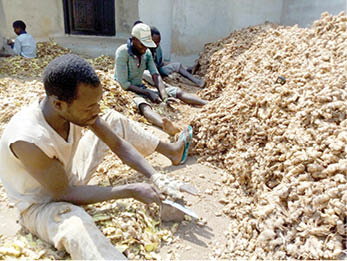The southern part of Kaduna State has long been the largest ginger production belt in Nigeria, producing over 70 per cent of the country’s 726,000 metric tons of the crop.
This year, however, the landscape is undergoing a dramatic transformation as farmers, overwhelmed by skyrocketing costs and the lingering effects of a devastating fungal disease, move towards a broader array of crops.
Last year, a severe fungal disease swept through Southern Kaduna, decimating ginger yields and leaving farmers with significant losses. The aftermath of this calamity has been compounded by soaring prices for essential farming inputs.
Fertilisers, herbicides, and ginger seeds have become expensive, making ginger farming a risky endeavour for many farmers in the area.
This has forced many farmers to diversify to other crops.
However, new ginger markets like Zonkwa are now thriving, as farmers from less affected areas around Atyap and Ikulu chiefdoms continue to produce the crop.
Ibrahim Hamza, a ginger farmer from Kachia, recounts the challenges faced by farmers in the region.
“The fungal disease hit us hard last year, and now the cost of ginger seeds and inputs is just too high,” he explains. “Many of us in Kachia, Jaba, and Kagarko LGAs have had to diversify and plant other crops like maize, rice, sweet potatoes, sugarcane, cassava, beans, corns, turmeric alongside ginger.
“The shift towards diversified farming is driven by economic necessity. The prices of fertilisers and herbicides have nearly doubled, and quality ginger seeds are scarce. This financial burden has prompted farmers to adapt by incorporating more resilient and cost-effective crops into their farming practices,” he said.
Among the affected farmers is Mr. Yohannah Usman, a seasoned ginger farmer from Gidan Mana in Kachia Local Government Area. “The fungal disease hit us hard last year,” he recalls, adding that “With the cost of ginger seeds and inputs rising, it has become too risky to rely solely on ginger. Many of us have no choice but to diversify.”
The high cost of inputs is a critical issue. The price of fertilisers has nearly doubled, herbicides have become a luxury, and quality ginger seeds are in short supply.
These economic pressures have forced farmers to rethink their strategies. Many are rotating to other crops or adopting mixed farming practices, incorporating more resilient and cost-effective options into their agricultural list.
Ibrahim Musa, another farmer from Jema’a Local Government Area, has chosen to plant maize and beans alongside his ginger crop. “We can’t afford to put all our resources into ginger alone. By planting maize and beans, we not only reduce our financial risk, but also ensure we have a harvest, no matter what happens,” he said.
Agricultural experts in the region are cautiously optimistic about this shift.
Yusuf Danjuma, an agronomist based in Southern Kaduna, notes that while the decline in ginger production is a setback, the move towards diversified farming could bolster food security.
“Farmers growing a variety of crops can lead to a more resilient agricultural sector,” he said, noting that: “It reduces dependency on a single crop and spreads the risk.”
Fields once dominated by ginger are now filled with maize, beans, sorghum and vegetables.
For many, the memory of last year’s fungal outbreak lingers as a stark reminder of the volatility of ginger farming.
“We’re still dealing with the remnants of the disease,” Amina Usman, a farmer from Zangon Kataf said, adding: “That is why I’m growing tomatoes and peppers now. I can’t afford to lose everything again.”
Farmers in Kagarko, Kachia, and Jaba LGAs are now turning to turmeric, cassava, sugarcane, beans, maize, and rice as alternatives.
Nathaniel Philemon, a ginger farmer from Kukui in Kagarko LGA, explained that ginger cultivation is more costly compared to the new crops being adopted.
“Ginger is capital intensive,” Philemon noted, adding that crops like cassava, sugarcane, and soybeans are more economical to grow.
“These crops are leguminous and self-fertilising, making them easier and cheaper for farmers to cultivate,” he stated.
Some farmers have also transitioned to growing guinea corn (sorghum), groundnuts, and soybeans as they all agreed that these alternatives require less financial investment than ginger.
Mr Ben, the manager of AFEX Company’s Kubacha Warehouse, shared a success story about his diversification into maize farming. Last year, he reported higher profits after switching to corn, and this year, he has planted 10 hectares of corn and two hectares of sorghum.
Farmers emphasised the need for modern farming equipment to enable large-scale agricultural practices. Philemon expressed the necessity for tractors, planters, and harvesters to move from small-scale to large-scale farming.
“To ensure adequate food supply, we need government support in providing subsidised modern farm equipment,” he said.
The farmers are hopeful that with the right tools and support, they can boost food production not just for personal consumption, but also to supply city dwellers and processing companies.
“As we navigate this new terrain, we are not only ensuring our livelihoods but also contributing to the region’s food security and economic resilience,” Shedrack Michael from Kukui, Kagarko LG told Weekend Trust.

 Join Daily Trust WhatsApp Community For Quick Access To News and Happenings Around You.
Join Daily Trust WhatsApp Community For Quick Access To News and Happenings Around You.


